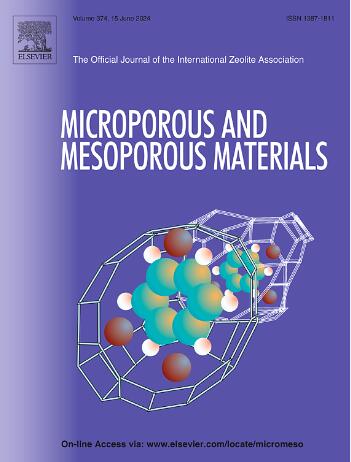微孔MOF-PSMA@MoO3复合材料高效吸附三甲胺
IF 4.8
3区 材料科学
Q1 CHEMISTRY, APPLIED
引用次数: 0
摘要
三甲胺(TMA)散发出强烈的鱼腥味,对人体健康和环境构成威胁,需要有效的吸附方法。该研究开创了一种新型复合吸附剂,通过聚苯乙烯-马来酸酐(PSMA)桥接将UiO-66-NH2与富氧空位的MoO3结合。这种创新的集成利用了金属有机框架(MOFs)的活性位点和MoO3的氧空位缺陷,协同增强了TMA的吸附能力,在313.15 K下达到168.45 mg g−1。采用综合表征技术对复合材料的结构和形态性能进行了分析。电子顺磁共振证实复合材料中氧空位增加。吸附遵循Langmuir等温线和拟二级动力学,表明是单层化学吸附。通过Zeta电位、x射线光电子能谱和傅里叶变换红外光谱进一步分析,揭示了吸附机理涉及静电相互作用、氢键和配位键。MOF-PSMA@MoO3卓越的吸附能力不仅在水产品加工、冷链物流和环境气味控制应用中为TMA缓解提供了新的见解。本文章由计算机程序翻译,如有差异,请以英文原文为准。

Microporous MOF-PSMA@MoO3 composite materials for efficient trimethylamine adsorption
Trimethylamine (TMA) emits a potent fishy odor and poses risks to both human health and the environment, necessitating effective adsorption methods. This study pioneered a novel composite adsorbent by integrating UiO-66-NH2 with oxygen vacancy-rich MoO3 via poly (styrene-alt-maleic anhydride) (PSMA) bridging. This innovative integration leveraged the active sites of metal-organic frameworks (MOFs) alongside oxygen vacancy defects of MoO3, synergistically enhancing TMA adsorption to an impressive capacity of 168.45 mg g−1 at 313.15 K. Comprehensive characterization techniques were employed to analyze the structural and morphological properties of the composites. Electron paramagnetic resonance confirmed increased oxygen vacancies in the composite. Adsorption followed Langmuir isotherm and pseudo-second-order kinetics, indicating monolayer chemisorption. Further analysis through Zeta potential, X-ray photoelectron spectroscopy, and Fourier transform infrared spectroscopy revealed an adsorption mechanism involving electrostatic interactions, hydrogen bonding, and coordination bonds. The exceptional adsorption capacity of MOF-PSMA@MoO3 offered new insights for TMA mitigation not only in aquatic product processing, cold-chain logistics, and environmental odor control applications.
求助全文
通过发布文献求助,成功后即可免费获取论文全文。
去求助
来源期刊

Microporous and Mesoporous Materials
化学-材料科学:综合
CiteScore
10.70
自引率
5.80%
发文量
649
审稿时长
26 days
期刊介绍:
Microporous and Mesoporous Materials covers novel and significant aspects of porous solids classified as either microporous (pore size up to 2 nm) or mesoporous (pore size 2 to 50 nm). The porosity should have a specific impact on the material properties or application. Typical examples are zeolites and zeolite-like materials, pillared materials, clathrasils and clathrates, carbon molecular sieves, ordered mesoporous materials, organic/inorganic porous hybrid materials, or porous metal oxides. Both natural and synthetic porous materials are within the scope of the journal.
Topics which are particularly of interest include:
All aspects of natural microporous and mesoporous solids
The synthesis of crystalline or amorphous porous materials
The physico-chemical characterization of microporous and mesoporous solids, especially spectroscopic and microscopic
The modification of microporous and mesoporous solids, for example by ion exchange or solid-state reactions
All topics related to diffusion of mobile species in the pores of microporous and mesoporous materials
Adsorption (and other separation techniques) using microporous or mesoporous adsorbents
Catalysis by microporous and mesoporous materials
Host/guest interactions
Theoretical chemistry and modelling of host/guest interactions
All topics related to the application of microporous and mesoporous materials in industrial catalysis, separation technology, environmental protection, electrochemistry, membranes, sensors, optical devices, etc.
 求助内容:
求助内容: 应助结果提醒方式:
应助结果提醒方式:


